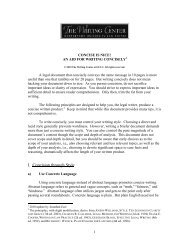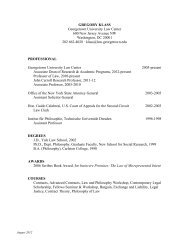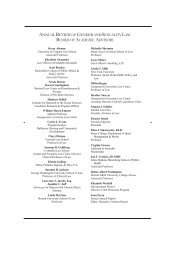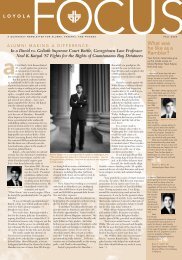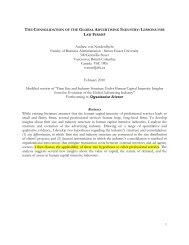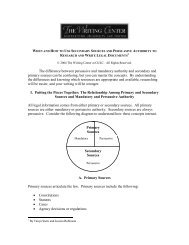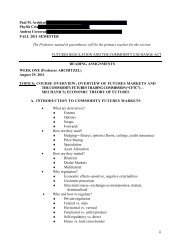Date: April 12, 2013 Topic: The Shrinking ... - Georgetown Law
Date: April 12, 2013 Topic: The Shrinking ... - Georgetown Law
Date: April 12, 2013 Topic: The Shrinking ... - Georgetown Law
Create successful ePaper yourself
Turn your PDF publications into a flip-book with our unique Google optimized e-Paper software.
General Counsel with Power? 2011 <br />
retailer in the UK has had a small in-‐house legal department which was often bypassed by the CEO and <br />
business managers who went direct to external lawyers for advice. According to the general counsel, <br />
‘our legal function was a little bit like an outside law firm dropped in here, and we sort of sat and waited <br />
for people round the business to come and talk to us, and then we’d give them some advice and then <br />
they’d go away. That was one part of the model. <strong>The</strong> other part was, we had outside lawyers that were <br />
more like in-‐house counsel.’ <br />
Externalizers Type 2 also rely heavily on external legal resources, but the in-‐house legal department has <br />
a proactive stance with respect to managing law firms. Typically, the general counsel hosts an annual <br />
conference of major law firms, and encourages lateral communication amongst these law firms in what <br />
they call a ‘legal community’, a ‘legal network’, or a virtual law firm. <strong>The</strong>se general counsel are adept at <br />
balancing collaboration and competition, in order to induce law firms to work effectively and efficiently <br />
for the corporate client (see Chapter 3 for details). <br />
Mid-rangers <br />
Financial services firms, including investment banks and commercial banks, are the biggest spenders on <br />
big law firms in absolute terms. However, proportionately their reliance on external lawyers relative to <br />
internal lawyers is balanced. This might conflate clear patterns in different lines of work, for example, <br />
heavier reliance on external lawyers in corporate finance than in sales and trading due to large amounts <br />
of complex documentation and the use of syndicates in the former. At the same time, some <br />
interviewees indicated that apart from ‘big ticket’ items such as large litigation cases, internal and <br />
external legal work was somewhat fungible. As a general counsel at an investment bank asked <br />
rhetorically: ‘What has to be done in-‐house? Nothing! A few years ago, I said to my bosses when we <br />
were having a debate about the structure of the legal department. I said we can hire another 200 <br />
lawyers and bring more of the work in-‐house, or we can fire all in-‐house lawyers and you two can <br />
manage all the outside counsel. Those are the two ends of the spectrum. <strong>The</strong> question to me is where <br />
do you want to be in the middle.’ However, apart from some consideration for managing the existing <br />
capacity and internal lawyers’ careers, the general counsel admitted to not being able to ‘articulate <br />
where on the spectrum we should be’. <br />
Internalizers <br />
<strong>The</strong> internalizers – with 20% or less reliance on external resources – use a different logic. <strong>The</strong>y have <br />
developed a strong in-‐house legal function that conducts most of the legal work for the corporation. <br />
<strong>The</strong> key advantage lies in in-‐house lawyers’ intimate knowledge of the business. Amongst the <br />
internalizers interviewed, a general counsel at an energy company considered heavy reliance on <br />
external legal resources as not cost-‐effective overall. Transacting with many outside counsel, <br />
‘constantly keeping them up to speed on what the business was doing’, was very expensive. <strong>The</strong> general <br />
counsel devised and implemented a law department strategy that placed importance on ‘fit-‐for-‐purpose’ <br />
lawyering, which involved staying very close to internal clients in business operations, and keeping tight <br />
control over external legal resources. Pursuing this strategy resulted in only <strong>12</strong>% of total legal spending <br />
going to external lawyers by 2010, down from 19% in 2005 and 23% in 2000. <br />
7 <br />
Said Business School | University of Oxford



